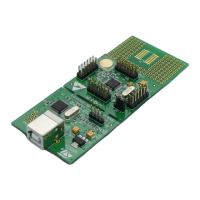RM0016 Inter-integrated circuit (I
2
C) interface
Doc ID 14587 Rev 8 281/449
21.4 I
2
C functional description
By default the I
2
C interface operates in Slave mode. To switch from default Slave mode to
Master mode a Start condition generation is needed.
21.4.1 I
2
C slave mode
The peripheral input clock must be programmed in the I2C_FREQR register in order to
generate correct timings. The peripheral input clock frequency must be at least:
● 1 MHz in Standard mode
● 4 MHz in Fast mode
As soon as a start condition is detected, the address is received from the SDA line and sent
to the shift register. Then it is compared with the address of the interface (OAR1L and OAR2
if ENDUAL = 1) or the General Call address (if ENGC = 1).
Note: In 10-bit addressing mode, the comparison includes the header sequence (11110xx0),
where xx denotes the two most significant bits of the address.
Header or address not matched: the interface ignores it and waits for another Start
condition.
Header matched (10-bit mode only): the interface generates an acknowledge pulse if the
ACK bit is set and waits for the 8-bit slave address.
Address matched: the interface generates in sequence:
● An acknowledge pulse if the ACK bit is set
● The ADDR bit is set by hardware and an interrupt is generated if the ITEVTEN bit is
set.
In 10-bit mode, after receiving the address sequence the slave is always in Receiver mode.
It will enter Transmitter mode on receiving a repeated Start condition followed by the header
sequence with matching address bits and the least significant bit set (11110xx1).
The TRA bit indicates whether the slave is in Receiver or Transmitter mode.

